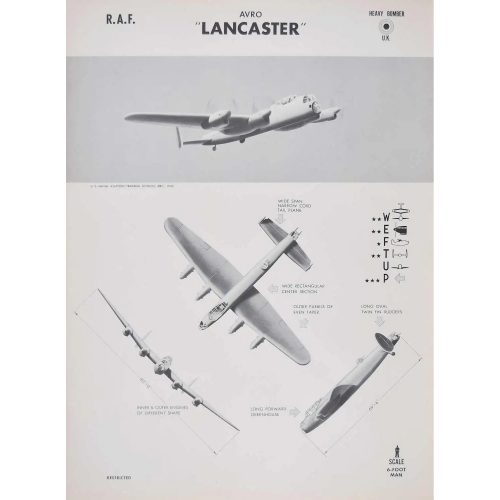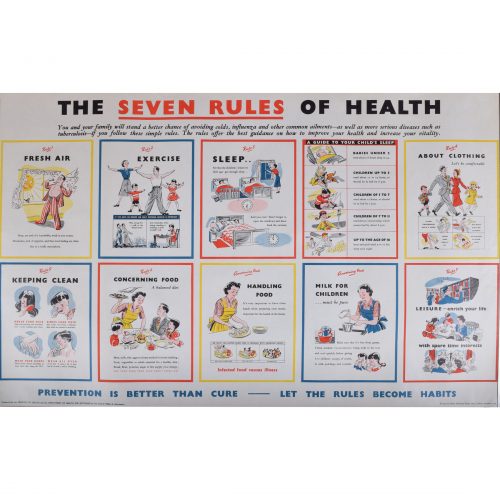-
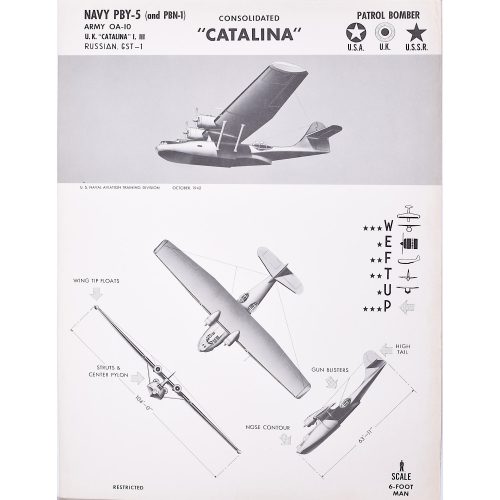
US Naval Aviation Training Division
Consolidated PBY Catalina World War 2 US airplane
Aeroplane identification poster, 1942 63 x 47 cm A particularly unusual style of aeroplane identification poster, owing to the very arty images. Most such posters rely on very plain silhouettes, this series - and we have several in this series (click here) - have a much more arty approach to the task with shading and an interesting angle view. The PBY Catalina is a flying boat used extensively during World War 2 in anti-submarine patrols, air-sea rescue, patrol bombing and convoy escort. It served militarily until the 1980s and was still being used in the 2010s as a waterbomber for firefighting. The RCAF called it the Canso. If you are interested, please email info@manningfineart.co.uk or call us on 07929 749056. -
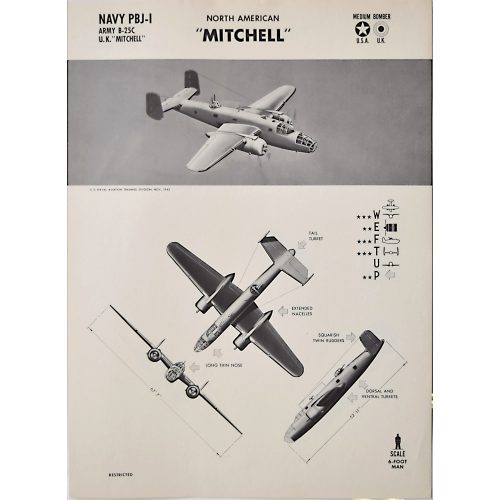
US Naval Aviation Training Division
B-25 Bomber North American Mitchell World War 2 US airplane
Original aeroplane identification poster, 1942 63 x 47 cm A particularly unusual style of aeroplane identification poster, owing to the very arty images. Most such posters rely on very plain silhouettes, this series - and we have several in this series - have a much more arty approach to the task with shading and an interesting angle view. Manufactured by North American Aviation and named in honour of Major General William 'Billy' Mitchell, a pioneer of US military aviation its first flight was in 1940 but it remained in service until 1979 (in the Indonesian air force). A particularly durable aircraft, one from the 321st Bomb Group was nicknamed 'Patches' on account of its (by the end of the war) 400 patched holes which had been painted with bright-yellow zinc chromate primer. Having completed over 300 missions and belly-landed six times the airframe was so distorted that 'straight-and-level' flight involved 8 degrees of left aileron trim and 6 degrees of right rudder causing the aircraft to 'crab' sideways through the air. Over one hundred B-25 Mitchells survive, with about 45 still airworthy. Seventeen flyable aircraft (and one hulk which was sacrificed to a crash scene) starred in the 1970 film 'Catch 22' fifteen of which still exist. If you are interested, please email info@manningfineart.co.uk or call us on 07929 749056. -
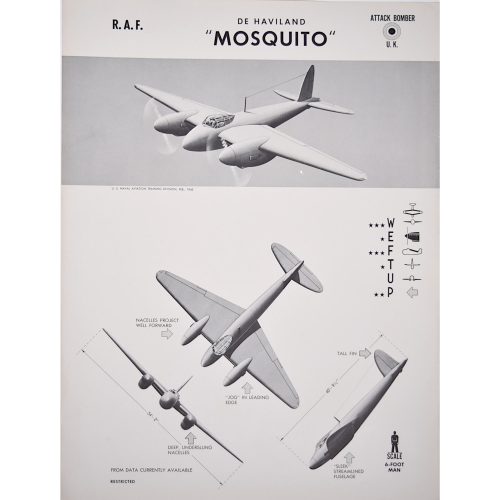
US Naval Aviation Training Division
DH Mosquito World War 2 US airplane
Original aeroplane identification poster, 1943 63 x 47 cm The Mosquito, the 'wooden wonder', was made entirely from wood to counteract metal shortages. Being wooden, it was very light, and when powered by two Merlin engines could outrun any German aeroplane, hence its use for Photographic Reconnaissance. Goering is reputed to have said: "In 1940 I could at least fly as far as Glasgow in most of my aircraft, but not now! It makes me furious when I see the Mosquito. I turn green and yellow with envy. The British, who can afford aluminium better than we can, knock together a beautiful wooden aircraft that every piano factory over there is building, and they give it a speed which they have now increased yet again. What do you make of that? There is nothing the British do not have. They have the geniuses and we have the nincompoops. When the war is over I shall buy a British radio set. Then at least I shall have something that works." If you are interested, please email info@manningfineart.co.uk or call us on 07929 749056. -
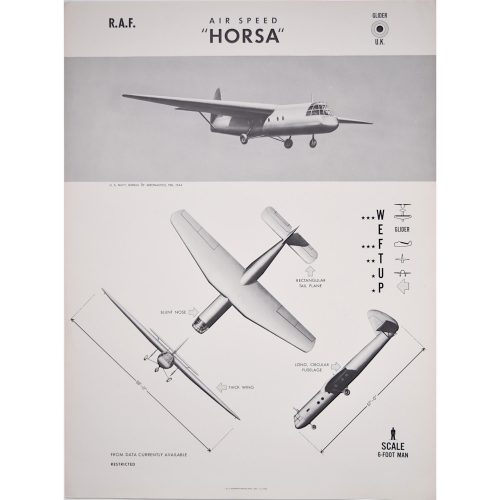
US Naval Aviation Training Division
Airspeed Horsa Glider World War 2 US airplane
Original aeroplane identification poster, 1943 63 x 47 cm In the days before helicopters it was gliders that allowed troops to be delivered to the ground. Essentially disposable aircraft (though obviously recovered where possible) they were light-weight and able to land in open fields where an aeroplane could not. Their ability to carry small tanks and other vehicles gave them a great advantage over simple paratroopers. Deployed to great effect in the D-Day Normandy landings and in the Market Garden advance, they were also widely used in Burma to supply the Chindits. One of the most terrifying methods of air transport during the War was the 'glider snatch'. A glider that had been used to deliver supplies or troops was reloaded with the wounded and then a passing aeroplane would pick up a rope attached to the front of the glider and snatch it into the air. The Horsa was a large glider, capable of accommodating 20-25 fully equipped paratroopers, and was first introduced in 1941. Made almost exclusively from wood - metal being in short supply - it was built by furniture factories. Between 3,799 and 5,000 Horsas were built - the varying numbers being down to the fact that many gliders were assembled at Maintenance Units rather than at the furniture factories (which lacked airfields). If you are interested, please email info@manningfineart.co.uk or call us on 07929 749056. -
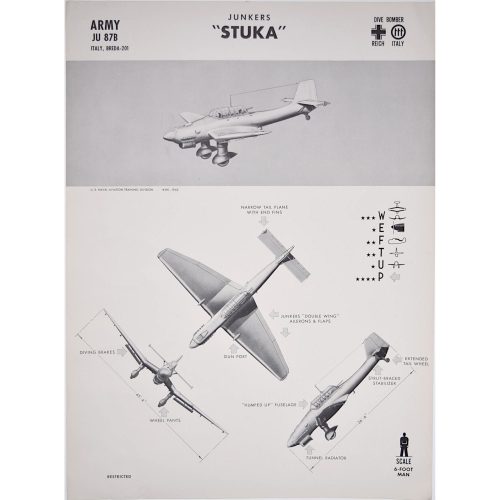
US Naval Aviation Training Division
Junkers Ju87 Stuka Dive Bomber - World War II aeroplane
Original aeroplane identification poster, 1943 63x47cm A particularly unusual style of aeroplane identification poster, owing to the very arty images. Most such posters rely on very plain silhouettes, this series - and we have several in this series (click here) - have a much more arty approach to the task with shading and an interesting angle view. Making its combat debut in 1937 with the Condor Legion during the Spanish Civil War it had a very distinctive silhouette as may be seen here. Essential to the rapid conquest of Norway, the Netherlands, Belgium and France in 1940 the Stuka was very effective against ground targets but vulnerable to fighter aircraft. It remained in service until the end of the War. If you are interested email info@manningfineart.co.uk or call us on 07929 749056. -
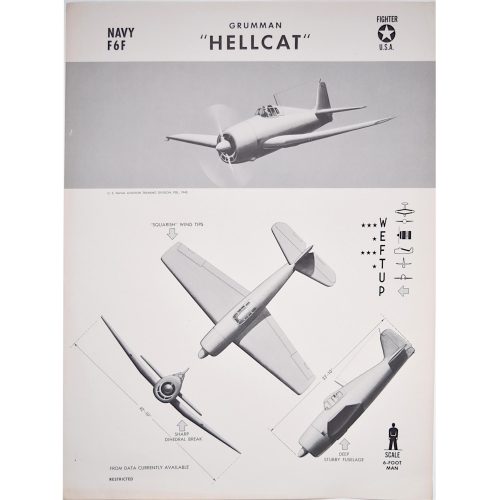
US Naval Aviation Training Division
Grumann F6F Hellcat World War 2 US airplane
Original aeroplane identification poster, 1943 63 x 47 cm The Grumman Hellcat was developed for the US Navy for the latter half of World War 2, becoming the dominant carrier-based aircraft being able to outperform the A6M Mitsubishi Zero. 12,275 were built in just over two years, being credited with 5,223 enemy kills - more than any other Allied naval aircraft. If you are interested, please email info@manningfineart.co.uk or call us on 07929 749056. -
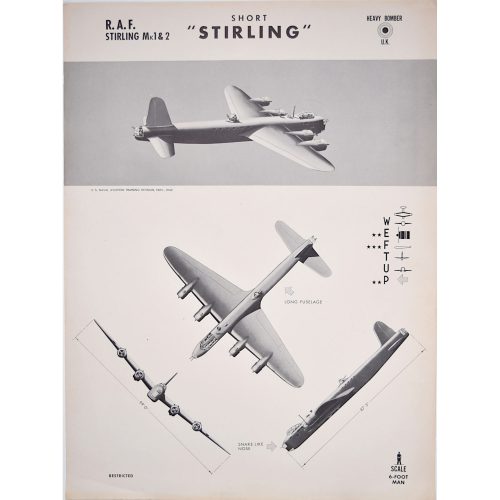
US Naval Aviation Training Division
Short Stirling World War 2 US airplane
Aeroplane identification poster, 1943 63 x 47 cm A particularly unusual style of aeroplane identification poster, owing to the very arty images. Most such posters rely on very plain silhouettes, this series - and we have several in this series (click here) - have a much more arty approach to the task with shading and an interesting angle view. Designed by Short Brothers, this was the RAF's first four-engined bomber entering service in 1941. Pilots liked its handling characteristics but the altitude ceiling was a matter of criticism and it was relegated to second-line duties in 1943 when the Halifax and Lancaster were available in sufficient numbers. It was subsequently used for mining harbours, as a glider tug and a supply aircraft. If you are interested, please email info@manningfineart.co.uk or call us on 07929 749056. -
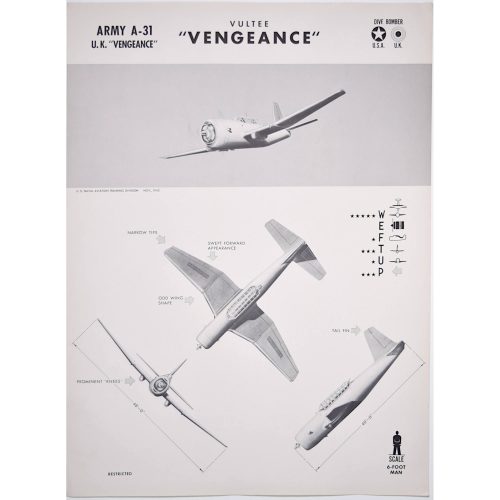
US Naval Aviation Training Division
1943 Vultee Vengeance World War 2 US airplane
Aeroplane identification poster, 1943 63 x 47 cm A particularly unusual style of aeroplane identification poster, owing to the very arty images. Most such posters rely on very plain silhouettes, this series - and we have several in this series (click here) - have a much more arty approach to the task with shading and an interesting angle view. Designed in 1940 as a single-engined dive bomber for the French Armée de l'Air, with deliveries scheduled for October 1940. With the fall of France in June 1940 the order was cancelled, but the British Royal Air Force ordered 200 of these dive bombers having been impressed by the Stuka. It was a reliable aircraft, stable in flight and in a dive. It was much used in Burma, this forgotten theatre of the war being regarded as a repository for otherwise unpopular and unwanted equipment, but where it proved very effective in bombing Japanese positions. If you are interested, please email info@manningfineart.co.uk or call us on 07929 749056. -

US Naval Aviation Training Division
Messerschmitt Bf 110 - World War II aeroplane
Aeroplane identification poster, 1943 63x47cm A particularly unusual style of aeroplane identification poster, owing to the very arty images. Most such posters rely on very plain silhouettes, this series - and we have several in this series (click here) - have a much more arty approach to the task with shading and an interesting angle view. A two-engined heavy fighter and fighter-bomber developed in German in the 1930s which saw service until the end of the war in 1945. It was a formidable radar-equipped night fighter with the top night-fighter ace Major Heinz-Wolfgang Schnaufer claiming 121 victories from 164 sorties. If you are interested email info@manningfineart.co.uk or call us on 07929 749056. -
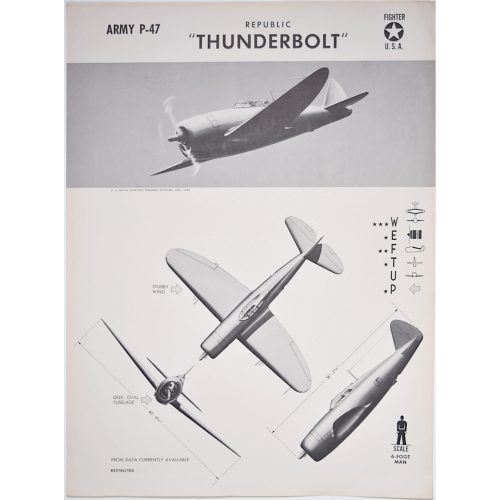
US Naval Aviation Training Division
Republic P47 Thunderbolt World War 2 US airplane
Aeroplane identification poster, 1943 63 x 47 cm A particularly unusual style of aeroplane identification poster, owing to the very arty images. Most such posters rely on very plain silhouettes, this series - and we have several in this series (click here) - have a much more arty approach to the task with shading and an interesting angle view. The Thunderbolt was produced between 1941 and 1945 as a fighter-bomber ground-attack airplane. POwered by a Pratt & Whitney R-2800 Double-Wasp engine it was successful both in European and Pacific theatres as one of the main USAAF fighters of the Second World War. Many remain airworthy, it being a popular 'warbird'. If you are interested, please email info@manningfineart.co.uk or call us on 07929 749056. -
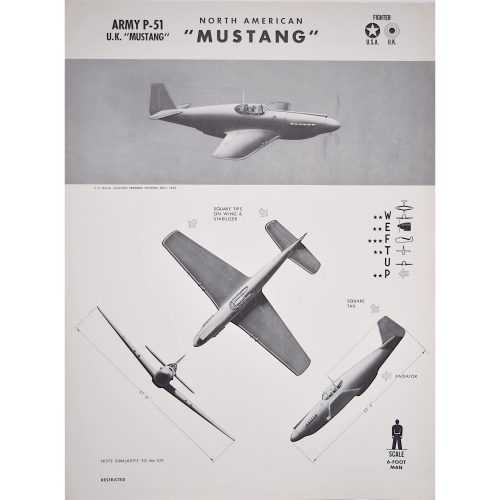
US Naval Aviation Training Division
North American Mustang P-51 World War 2 US airplane
Aeroplane identification poster, 1943 63x47cm A particularly unusual style of aeroplane identification poster, owing to the very arty images. Most such posters rely on very plain silhouettes, this series - and we have several in this series (click here) - have a much more arty approach to the task with shading and an interesting angle view. The Mustang is a long-range single-seat fighter/fighter-bomber that saw service during both the Second World War and Korean War. It was designed in 1940 by North American Aviation when they were commissioned to build Curtiss P-40 fighters under licence for the British Royal Air Force. Rather than build an old design, they designed this new aeroplane; the prototype was rolled out 102 days after the contract was signed. Powered by a Rolls-Royce Merlin engine over 15,000 were built with their most important role being escorting bombers over Germany. During World War II Mustang pilots accounted for a claimed 4,950 enemy aircraft. Today many survive and are a very popular 'warbird'. If you are interested email info@manningfineart.co.uk or call us on 07929 749056. -
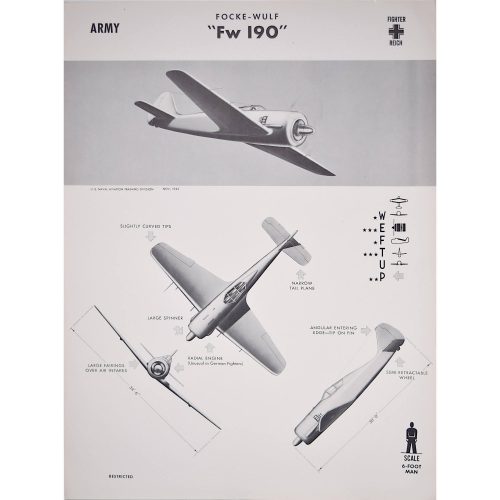
US Naval Aviation Training Division
Luftwaffe Focke-Wulf Fw190 - World War II aeroplane
Aeroplane identification poster, 1943 63 x 47cm A particularly unusual style of aeroplane identification poster, owing to the very arty images. Most such posters rely on very plain silhouettes, this series - and we have several in this series (click here) - have a much more arty approach to the task with shading and an interesting angle view. The Würger (in English, Shrike) is a single-seat single-engined fighter airplane widely used during World War II by the Germans. Designed in 1936 over 20,000 were built, beginning operations in August 1941 outclassing the Spitfire Mk V - remaining so until the Spitfire Mk IX was introduced. Both the French Air Force and French Navy purchased and operated the Fw 190 following the end of the war. Today some 28 examples survive, plus 20 modern reproductions. If you are interested, please email info@manningfineart.co.uk or call us on 07929 749056. -

US Naval Aviation Training Division
Luftwaffe Dornier Do 217 Medium/Heavy Bomber
Aeroplane identification poster, 1943 63x47cm A particularly unusual style of aeroplane identification poster, owing to the very arty images. Most such posters rely on very plain silhouettes, this series - and we have several in this series (click here) - have a much more arty approach to the task with shading and an interesting angle view. A two-engined heavy bomber developed in German in the late 1930s for short-range bombing and as a more powerful development of the Do 17 - the flying pencil. It saw service until the end of the war in 1945. A versatile aircraft it was used as a night fighter, torpedo bomber, strategic bomber and reconnaissance aircraft. No complete example survives to this day despite a production of 1,925. If you are interested email info@manningfineart.co.uk or call us on 07929 749056. -

What to Eat and Why
Original Poster 51x76cm If you are interested email info@manningfineart.co.uk or call us on 07929 749056. -
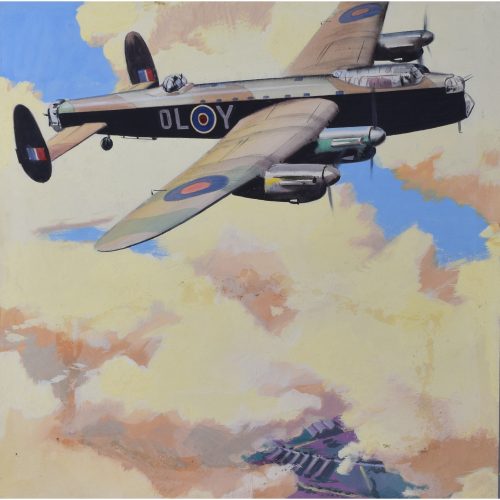
Ernest Bendell-Bayly Lancaster Bomber
Oil on paper laid on board 39x38cm Design for a poster 1940s If you are interested email info@manningfineart.co.uk or call us on 07929 749056. Ernest Bendell-Bayly was a partner in the Bayly-Souster advertising agency, employer of, amongst others, Owen Miller. They produced many posters for the Ministry of Aircraft Production during the war. -
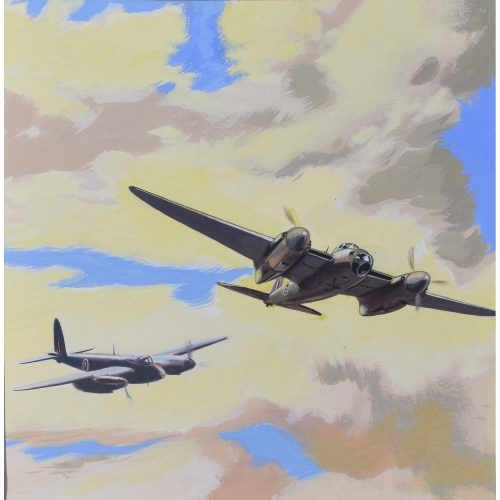
Ernest Bendell-Bayly Mosquito Fighter Bomber
Oil on paper laid on board Design for poster 32x31cm 1940s Ernest Bendell-Bayly was a partner in the Bayly-Souster advertising agency, employer of, amongst others, Owen Miller. If you are interested email info@manningfineart.co.uk or call us on 07929 749056. -
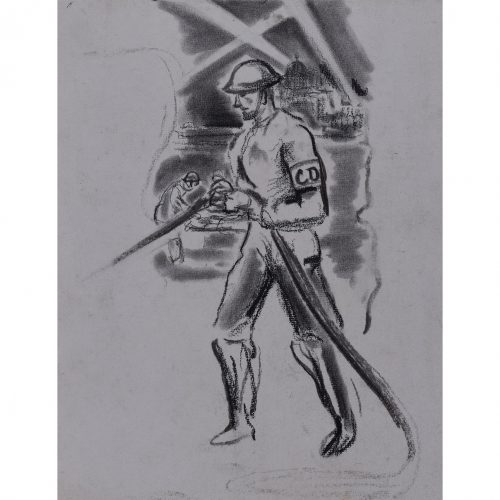
The Blitz: A Civil Defence Firefighter In Action before St Paul's Cathedral with Search Lights and Stretcher Bearers
Charcoal c. 1940 30x24cm A World War II Civil Defence firefighter, with 'CD' armband operates a fire hose as stretcher bearers work behind him, St Paul's cathedral being illuminated by searchlights. A typical night-time scene from London during the 1940 Blitz. If you are interested email info@manningfineart.co.uk or call us on 07929 749056. -
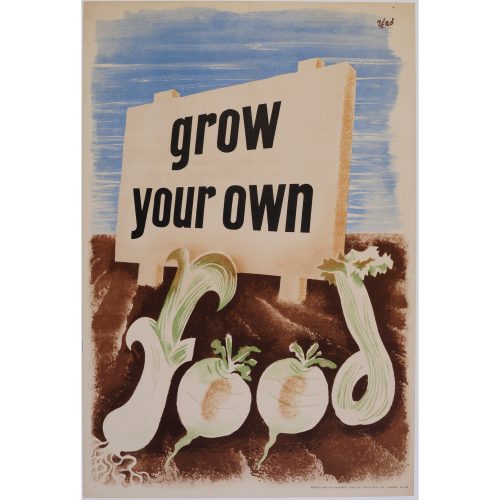
'Zero' Hans Schleger (1898-1976) Grow Your Own Food
Lithographic poster c. 1940 Printed by Fosh & Kosh Limited for HMSO 76x51cm A copy of this poster is in the collection of the Imperial War Museum. Click here for biographical details and other posters by Hans 'Zero' Schleger. Provenance: the estate of the artist. If you are interested email info@manningfineart.co.uk or call us on 07929 749056. -
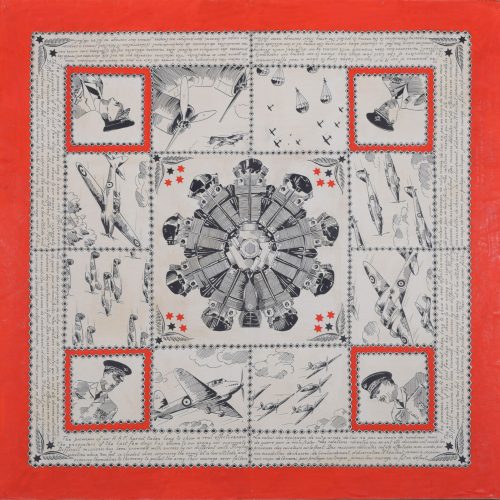
Design for Bianchini Ferier, Lyon for a scarf
Pen and Gouache c. 1940 75cm x 75cm "The prowess of our R.A.F. has not taken long to show a real effectiveness. The encounters of the last few days has sown to our enemy our supremacy. Difficult missions have been crowned with success by our different units. Flying sometime above 7000 feet in clouded skies surprising the enemy at a low altitude and exposing themselves to the enemy to protect the army. Their courage never falters." In the months prior to the Fall of France in May 1940 - before the Battle of Britain began - the RAF was in action in the skies above France and this design for a scarf depicts aeroplanes and pilots of the RAF. -
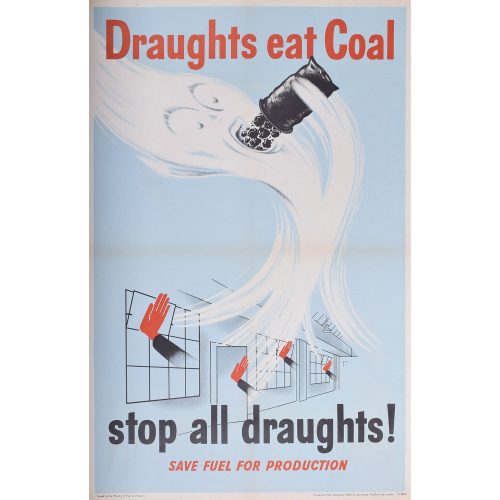
Anonymous
Draughts Eat Coal - Stop All Draughts! Save Fuel for Production
Lithographic poster 76 x 50cm Issued by the Ministry of Fuel and Power Printed for HM Stationery Office by J Weiner Ltd, London WC1 Fuel was needed for production of munitions and machinery, as well as to drive the machinery. The population was therefore exhorted not to waste fuel. Successful Home Front propaganda posters, as Fougasse proved, needed to amuse the watcher; cartoonists were accordingly highly regarded for this task. -
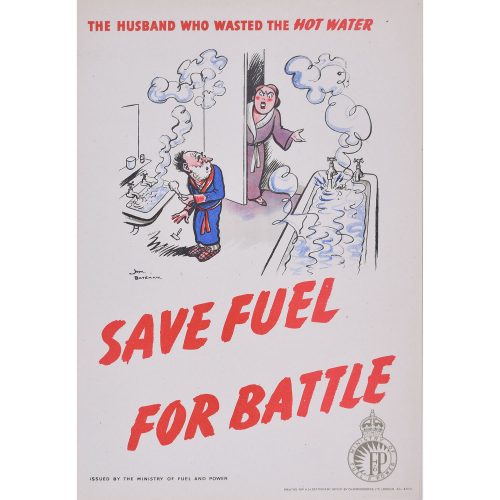
H. M. Bateman (1887-1970)
Save Fuel for Battle (the husband who wasted the hot water)
Lithographic poster c. 1940 For HMSO by Chromoworks. Ministry of Fuel & Power 38x26cm If you are interested email info@manningfineart.co.uk or call us on 07929 749056. -
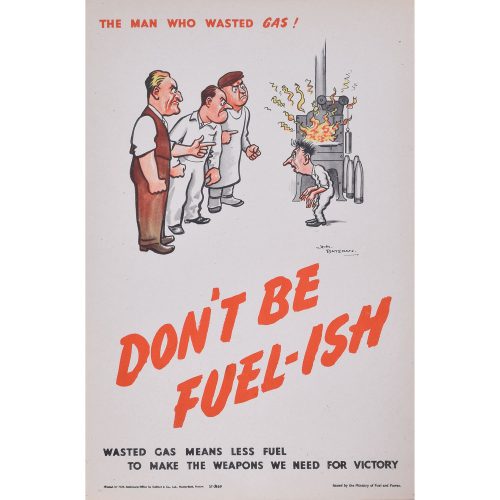
H. M.Bateman
Don't be Fuel-ish (the man who wasted gas)
Lithographic poster c.1940 For HMSO by Chromoworks. Ministry of Fuel & Power 38x26cm If you are interested email info@manningfineart.co.uk or call us on 07929 749056. -
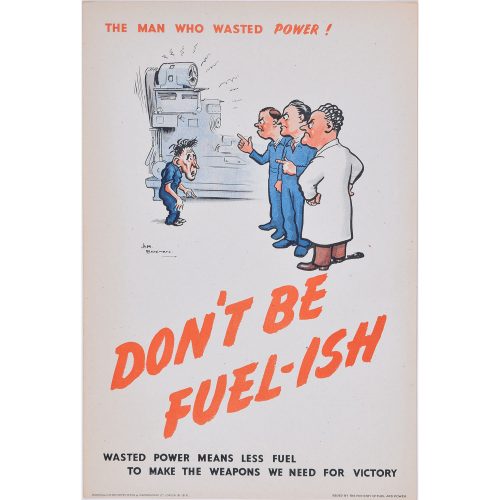
H. M. Bateman (1887-1970)
Don't be Fuel-ish (the man who wasted power)
Lithographic poster 38x26cm If you are interested email info@manningfineart.co.uk or call us on 07929 749056. -
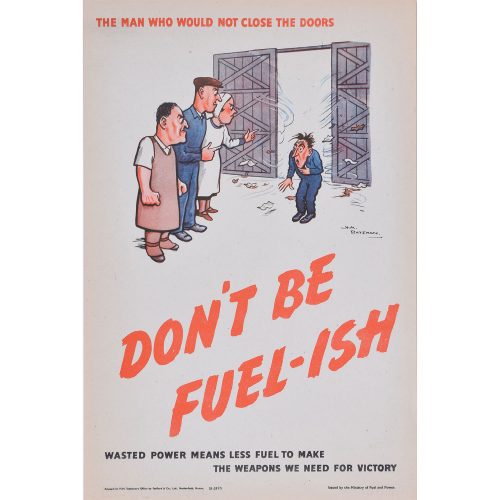
H. M. Bateman
Don't be Fuel-ish (the man who would not close the doors)
Lithographic poster 38x26cm If you are interested email info@manningfineart.co.uk or call us on 07929 749056. -
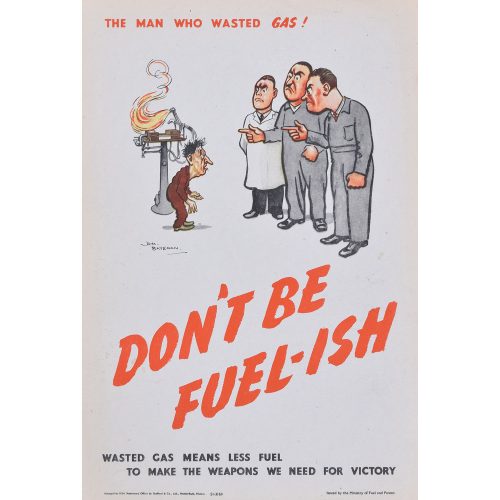
H. M. Bateman (1887-1970)
Don't be Fuel-ish (the Man who Wasted Gas II)
For HMSO by Chromoworks. Ministry of Fuel & Power Lithographic poster c. 1940 38x26cm If you are interested email info@manningfineart.co.uk or call us on 07929 749056. -
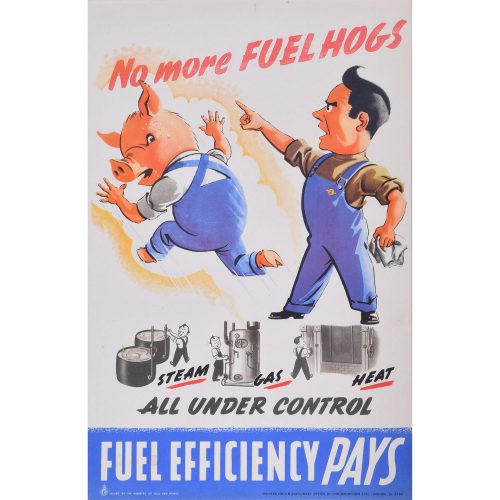
No more Fuel Hogs
Steam, Gas, Heat, all under control. Fuel Efficiency Pays Lithographic poster c. 1940 Printed for HMSO by Chromoworks Limited and issued by the Ministry of Fuel and Power 37x24cm If you are interested email info@manningfineart.co.uk or call us on 07929 749056. -
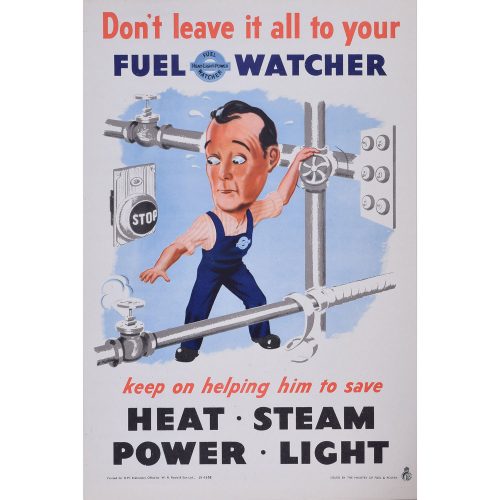
Don't leave it all to your fuel watcher
Keep on helping him to save HEAT STEAM POWER LIGHT Lithographic poster c. 1940 for HMSO by W R Royle & Son and issued by the Ministry of Fuel and Power 38x25cm If you are interested email info@manningfineart.co.uk or call us on 07929 749056. -
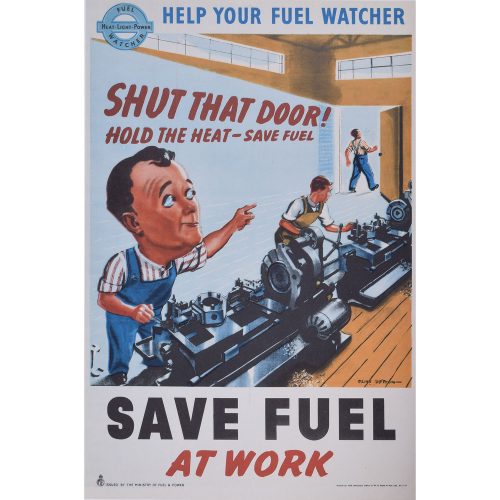
Clive Uppton (1911-2006)
Save Fuel at Work: Shut that Door! Hold the Heat - Save Fuel
Lithographic poster c. 1940 37x25cm Uptton was a widely-published artist, political cartoonist of the Daily Sketch and Sunday Graphic from 1940-42. If you are interested email info@manningfineart.co.ukor call us on 07929 749056. -
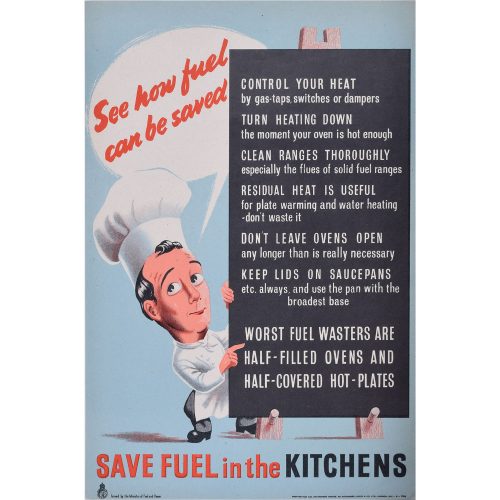
Save Fuel in the Kitchens
Lithographic poster c. 1940 37x25cm Printed for HMSO by Nathaniel Lloyd and Co for the Ministry of Fuel and Power Energy was urgently needed to make bombs and fuel the vehicles of war. Britons were endlessly exhorted to save fuel; a message that has no less resonance today. If you are interested email info@manningfineart.co.ukor call us on 07929 749056. -
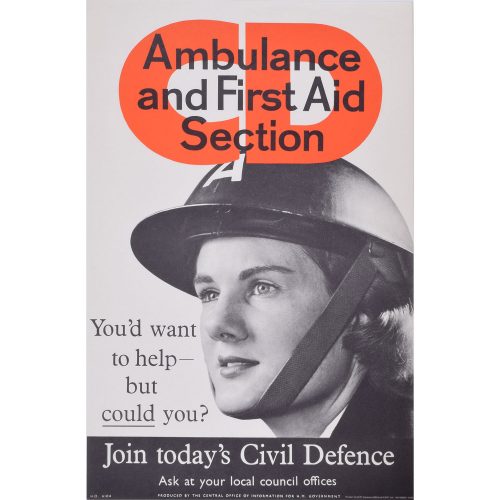
Ambulance and First Aid Section
Lithographic poster probably c. 1940s 36x23cm First established in 1935 the Civil Defence Department was essential for maintaining order during air raids. Here a glamorous young lady - presumably unable to join the army - is volunteering to 'do her bit' by driving an ambulance. If you are interested email info@manningfineart.co.ukor call us on 07929 749056. -
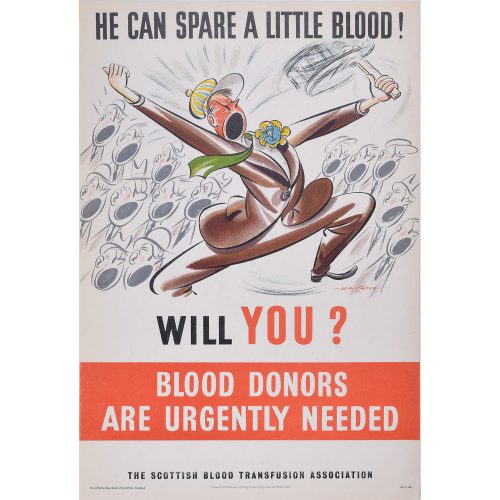
Allan Carter
He can spare a little blood - Blood Donors are Urgently Needed
Lithographic poster c. 1940s 38x25cm Printed for HMSO by Sanders Phillips & Co. The Scottish Blood Transfusion Association If you are interested email info@manningfineart.co.ukor call us on 07929 749056. -
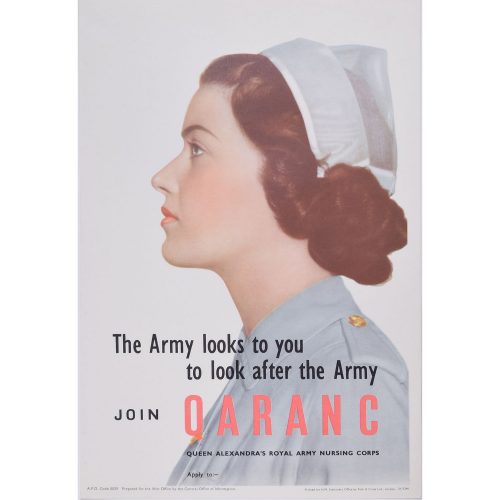
Join QARANC - Queen Alexandra's Royal Army Nursing Corps
The Army looks to you to look after the Army
Lithographic poster c. 1940s 38x25cm Printed for HMSO by Fosh & Kosh Limited, London and prepared for the War Office by the Central Office of Information. If you are interested email info@manningfineart.co.ukor call us on 07929 749056. -
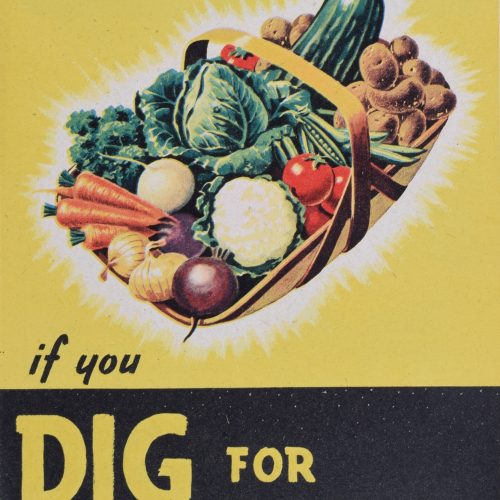
Dig for Victory Now
Norman Wilson, c1940
Dig for Victory Now Lithograph 18x12cm (7×4.7 inches), price includes frame. When rationing was at its height, what could be more appealing than a basket of fresh vegetables. What more incentive could be required to Dig For Victory Now? If you are interested email info@manningfineart.co.uk or call us on 07929 749056. -
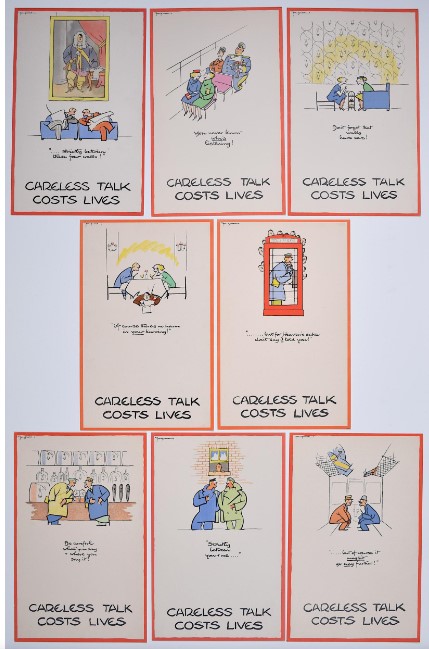
Cyril Kenneth Bird ‘Fougasse’ (British, 1887-1965)
Careless Talk Costs Lives
Lithographic posters c1940 32 x 20 cm (12.5 x 8 in) Set of eight and individual posters available, please call for current stock. Further biographical details and items by Fougasse are available here. If you are interested email info@manningfineart.co.uk or call us on 07929 749056. -
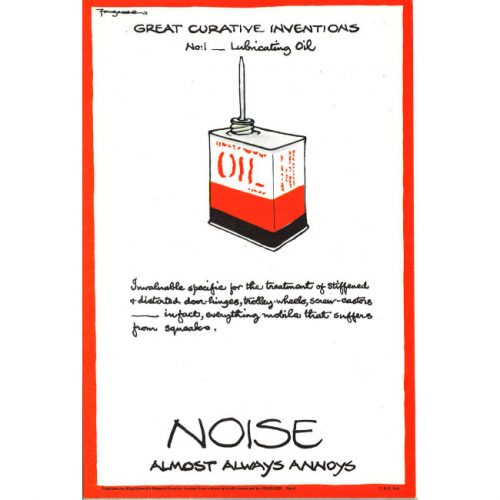
Cyril Kenneth Bird ‘Fougasse’ (British 1887-1965)
Noise Almost Always Annoys
Lithographic poster c1940 29.5 x 19.6 cm (11.5 x 7.5 in) printed by Fosh & Cross Ltd. “Published by King Edward’s Hospital Fund for London from a drawing kindly presented by Fougasse. No. 6. F&C Ltd.” Further biographical details and items by Fougasse are available here. If you are interested email info@manningfineart.co.uk or call us on 07929 749056. -
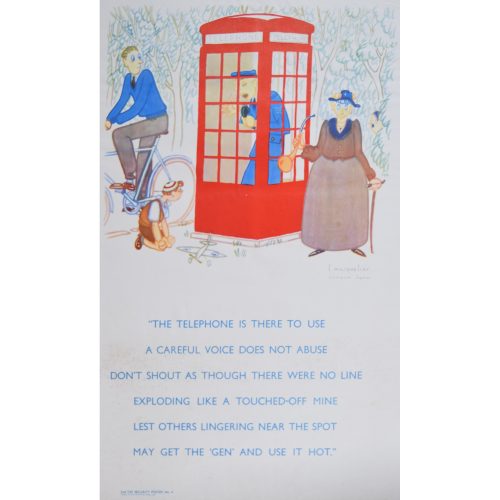
Louis Masquelier (1898-1945)
The Telephone
L. Masquelier/ Lorraine Sqdrn. (2nd TAF Security Poster No.4) Lithographic Poster 55x34.5cm Issued by the 2nd Tactical Airforce ('TAF'). This was a combination of both fighter and bomber units formed for the purposes of supporting the army in the 1944 invasion of Europe. The artist was a Sergent-chef (sergeant) in No 342 (Lorraine) Squadron RAF, a Free French Squadron transferred back to the Armée de l'Air in December 1945. An air gunner - and relatively old at 41 at the beginning of the war - he flew on many operations, also serving as cine-cameraman thanks to his artistic skills. He died on 28 May 1945, after the end of the war. Here a Frenchman has depicted that most English of items, Giles Gilbert Scott's K2 telephone box warning members of the 2nd TAF to be careful when using the telephone. If you are interested email info@manningfineart.co.uk or call us on 07929 749056. -
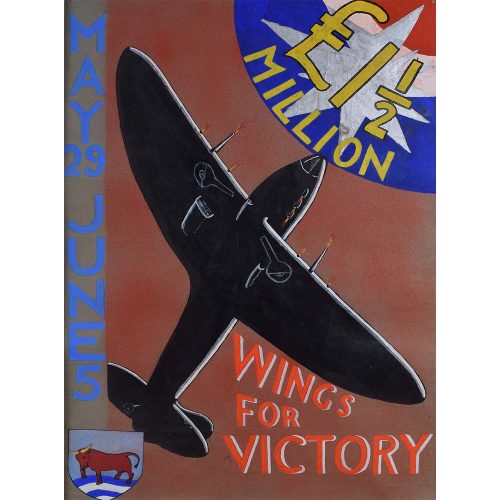
Anonymous
Oxford Wings for Victory Poster Design
56x38cm 62x44cm including hand-finished black frame. Gouache on paper c. 1943 Click here to see other posters from this series and for more information on Wings for Victory campaigns. If you are interested email info@manningfineart.co.uk or call us on 07929 749056. Condition: excellent, framed. -
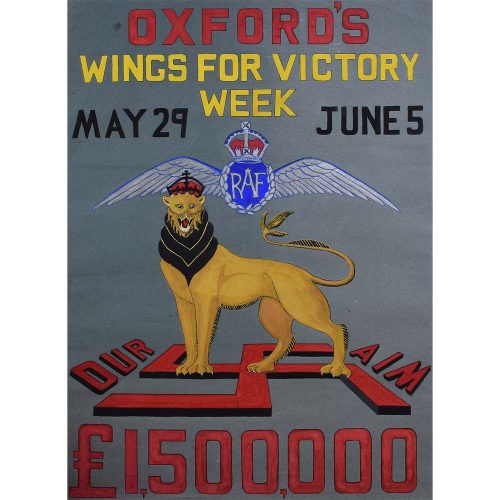
Anonymous
Oxford Wings for Victory Poster Design IV
c.1943 Gouache on paper 70 x 51 cm 89 x 68 cm including hand-finished frame, UK shipping only Click here to see other posters from this series. If you are interested email info@manningfineart.co.uk or call us on 07929 749056. Condition: Excellent. -
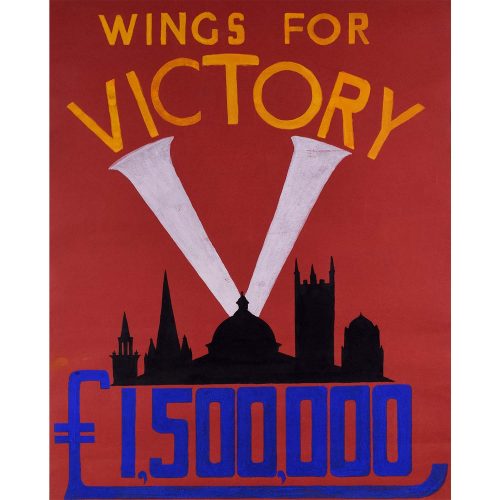
Anonymous
Oxford Wings for Victory Poster Design II
c.1943 Gouache on paper 63 x 50 cm 81x66cm including hand-finished frame, UK shipping only Click here to see other posters from this series. If you are interested email info@manningfineart.co.uk or call us on 07929 749056. Condition: Excellent. -
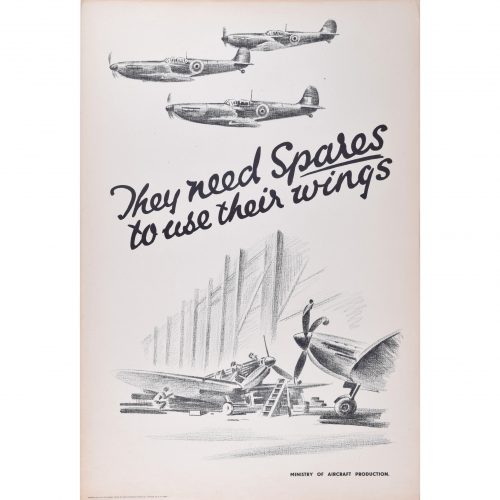
Owen Miller (1907-1960)
They need spares to use their wings
Original poster c. 1943 76x51cm Printed for HMSO by Multi Machine Plates Ltd for the Ministry of Aircraft Production Damaged Spitfires are pictured waiting in a hanger for spares to arrive, encouraging the workers in the factory to work harder in order to keep the aeroplanes in the air. Click here for biographical details and other works by the artist. If you are interested email info@manningfineart.co.uk or call us on 07929 749056. -
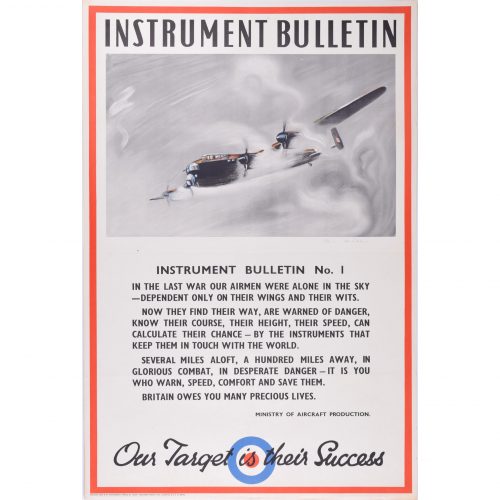
Owen Miller (1907-1960)
Instrument Bulletin No. 1 - Lancaster Bomber
Our Target is Their Success Original poster c. 1943 75x49cm Printed for HMSO by Multi Machine Plates Ltd for the Ministry of Aircraft Production In the last war our airmen were alone in the sky - dependent only on their wings and their wits. Now they find their way, are warned of danger, know their course, their height, their speed, can calculate their change - by the instruments that keep them in touch with the world. Several miles aloft, a hundred miles away, in glorious combat, in desperate danger - it is you who warn, speed, comfort and save them. Britain owes you many precious lives. Click here for biographical details and other works by the artist. If you are interested email info@manningfineart.co.uk or call us on 07929 749056. -

Owen Miller (1907-1960)
You’ve got a Good Case
Ministry of Aircraft Production, Printed for HMSO by Fosh & Cross c. 1940 Lithographic poster This poster was one of a series produced by Miller to encourage efficiency in aircraft factories, probably in 1942. 30×20 inches Click here for biographical details and other works by the artist. If you are interested email info@manningfineart.co.uk or call us on 07929 749056. -
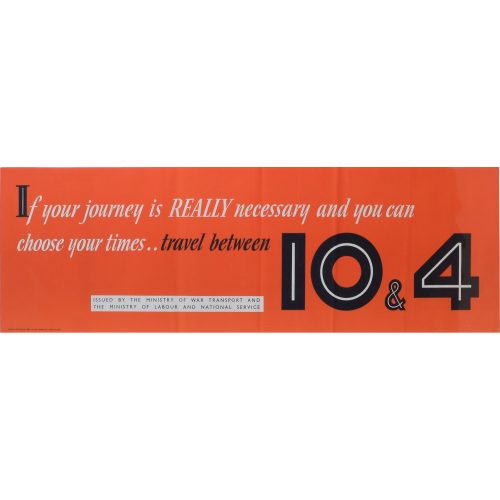
Printed for H.M. Stationery Office, c.1943
If your journey is REALLY necessary and you can choose your times… travel between 10 and 4
Issued by the Ministry of War Transport and the Ministry of Labour and National Service 18×75 cm (7″ x 30″) in unissued condition If you are interested email info@manningfineart.co.uk or call us on 07929 749056.

